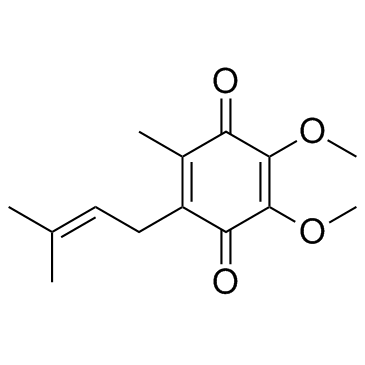Ubiquinone-1

Ubiquinone-1 structure
|
Common Name | Ubiquinone-1 | ||
|---|---|---|---|---|
| CAS Number | 727-81-1 | Molecular Weight | 250.29000 | |
| Density | 1.1g/cm3 | Boiling Point | 389.1ºC at 760 mmHg | |
| Molecular Formula | C14H18O4 | Melting Point | N/A | |
| MSDS | Chinese USA | Flash Point | 172ºC | |
|
Contribution of dopamine to mitochondrial complex I inhibition and dopaminergic deficits caused by methylenedioxymethamphetamine in mice.
Neuropharmacology 93 , 124-33, (2015) Methylenedioxymethamphetamine (MDMA) causes a persistent loss of dopaminergic cell bodies in the substantia nigra of mice. Current evidence indicates that MDMA-induced neurotoxicity is mediated by oxidative stress probably due to the inhibition of mitochondri... |
|
|
Production of new amilorides as potent inhibitors of mitochondrial respiratory complex I.
Biosci. Biotechnol. Biochem. 79 , 1061-6, (2015) Amilorides, well-known inhibitors of Na(+)/H(+) antiporters, have also shown to inhibit bacterial and mitochondrial NADH-quinone oxidoreductase (complex I). Since the membrane subunits ND2, ND4, and ND5 of bovine mitochondrial complex I are homologous to Na(+... |
|
|
Sphingomonas panaciterrae sp. nov., a plant growth-promoting bacterium isolated from soil of a ginseng field.
Arch. Microbiol. 197 , 973-81, (2015) Strain DCY91(T), a Gram-stain-negative, rod-shaped, aerobic, non-motile bacterium, was isolated from soil of ginseng field in Gyeonggi province, South Korea. Strain DCY91(T) shared the highest 16S rRNA gene sequence similarity with Sphingomonas mucosissima DS... |
|
|
Vibration mechanosignals superimposed to resistive exercise result in baseline skeletal muscle transcriptome profiles following chronic disuse in bed rest.
Sci. Rep. 5 , 17027, (2015) Disuse-induced muscle atrophy is a major concern in aging, in neuromuscular diseases, post-traumatic injury and in microgravity life sciences affecting health and fitness also of crew members in spaceflight. By using a laboratory analogue to body unloading we... |
|
|
Diagnostic use of cerebral and extracerebral oxysterols.
Clin. Chem. Lab Med. 42(2) , 186-91, (2004) 24S-Hydroxycholesterol (24OHC) and 27-hydroxycholesterol (27OHC) are two structurally similar oxysterols of different origins--the former almost exclusively formed in the brain and the latter formed to a lesser extent in the brain than in most other organs. H... |
|
|
Levels of 7-oxocholesterol in cerebrospinal fluid are more than one thousand times lower than reported in multiple sclerosis.
J. Lipid Res. 46(2) , 191-5, (2005) In a recent publication [Diestel, A., O. Aktas, D. Hackel, I. Hake, S. Meier, C. S. Raine, R. Nitsch, F. Zipp, and O. Ullrich. 2003. Activation of microglial poly (ADP-ribose)-polymerase-1 by cholesterol breakdown products during neuroinflammation: a link bet... |
|
|
Disruption of thiol homeostasis and nitrosative stress in the cerebrospinal fluid of patients with active multiple sclerosis: evidence for a protective role of acetylcarnitine.
Neurochem. Res. 28(9) , 1321-8, (2003) Recent studies suggest that NO and its reactive derivative peroxynitrite are implicated in the pathogenesis of multiple sclerosis (MS). Patients dying with MS demonstrate increased astrocytic inducible nitric oxide synthase activity, as well as increased leve... |
|
|
Folate and methylation status in relation to phosphorylated tau protein(181P) and beta-amyloid(1-42) in cerebrospinal fluid.
Clin. Chem. 53(6) , 1129-36, (2007) Increased plasma total homocysteine (tHcy) is a risk factor for neurological diseases, but the underlying pathophysiology has not been adequately explained.We evaluated concentrations of tHcy, S-adenosyl homocysteine (SAH), S-adenosyl methionine (SAM), folate... |
|
|
Serum uric acid levels in multiple sclerosis patients correlate with activity of disease and blood-brain barrier dysfunction.
Eur. J. Neurol. 9(3) , 221-6, (2002) Several findings suggest lower levels of serum uric acid in multiple sclerosis (MS) patients. The aim of this study is to investigate relationships of uric acid serum levels in relapse-remitting (RR) MS patients with clinical activity of disease and blood-bra... |
|
|
Inflammatory multiple-sclerosis plaques generate characteristic metabolic profiles in cerebrospinal fluid.
PLoS ONE 2(7) , e595, (2007) Multiple sclerosis (MS), an inflammatory disease of the central nervous system, manifests itself in numerous forms and stages. A number of brain metabolic alterations have been reported for MS patients vs. control subjects. However, metabolite profiles of cer... |